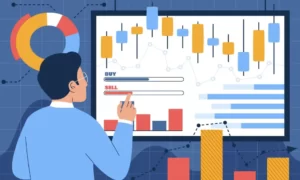
Mastering Price Action Trading
Transform Your Trading: From Noob to Pro
Welcome back to the blog, everyone. Today, we dive into the core principles of price action trading to ensure your charts never look like a beginner’s again. By mastering the interpretation of market movements, you can significantly enhance your trading skills and profitability.
Price Action Trading: The Core of Market Analysis
Price action trading, also known as naked trading, is a method that involves understanding how price moves without relying on indicators. Instead of being clouded by numerous indicators, price action trading focuses on the raw price movements. This approach allows traders to gain deep insights into market behavior, making more informed trading decisions.
The Three Market Movements
Price can only do three things: go up, go down, or stay flat. Recognizing these movements is crucial for any trader. Here’s how you can identify each:
Uptrend
In an uptrend, the price creates a series of higher highs and higher lows. This indicates that the market sentiment is bullish, and buyers are in control.
Downtrend
In a downtrend, the price forms a series of lower lows and lower highs. This shows that the market sentiment is bearish, and sellers are in control.
Consolidation
When the price moves sideways, it indicates market indecision. This period of sideways movement is known as consolidation, which is often a precursor to a significant move once the price breaks out of the range.
Recognizing Patterns and Formations
Candlestick patterns provide crucial clues about future price movements. Here are some key patterns every trader should know:
Bearish and Bullish Candles
These candles signal the market direction. A bullish candle indicates that the buyers have been able to push the price higher, while a bearish candle shows that sellers have managed to drive the price lower.
Indecision Candles
These candles, often referred to as Doji candles, indicate potential reversals or continuations. They show that neither buyers nor sellers have gained control, resulting in a stalemate.
Patterns
Groups of candles that form recognizable patterns reveal market sentiment. Common patterns include the Head and Shoulders, Double Top and Bottom, and various triangle formations. These patterns help traders predict future price movements based on historical price action.
Support and Resistance Levels
Understanding how to spot resistance (the ceiling) and support (the floor) levels is vital:
Resistance
A resistance level is where the price struggles to rise above. This level acts as a ceiling, preventing the price from moving higher.
Support
A support level is where the price struggles to fall below. This level acts as a floor, holding the price up.
Recognizing these levels helps in predicting breakouts and market movements. When the price breaks through resistance, it often continues higher. Conversely, when it breaks through support, it tends to move lower.
Advanced Price Action Techniques
Integrating advanced concepts into your trading strategy can significantly improve your performance:
Fibonacci Retracements
Fibonacci retracements help identify potential reversal levels within trends. By drawing Fibonacci levels on a chart, traders can predict areas where the price might retrace before continuing in the direction of the trend.
Volume Analysis
Volume analysis is crucial for understanding how trading volume affects price movements. High volume during a price move indicates strong interest and can confirm the direction of the trend. Conversely, low volume might suggest a lack of interest and potential reversals.
Divergences
Divergences occur when the price moves in one direction while an indicator moves in the opposite direction. Using divergences can help traders spot potential reversals early.
Real-Life Application: The Charts
To truly understand price action trading, you need to apply these concepts to live charts. Observing how price action unfolds in real-time allows you to practice and refine your trading skills. Here’s a step-by-step guide to applying price action principles:
- Identify the Trend: Determine if the market is in an uptrend, downtrend, or consolidation phase.
- Spot Key Levels: Identify support and resistance levels on the chart.
- Recognize Patterns: Look for candlestick patterns and formations that indicate potential price movements.
- Confirm with Volume: Use volume analysis to confirm the strength of the trend or potential reversals.
- Plan Your Trade: Based on your analysis, decide on entry and exit points, and set your stop-loss and take-profit levels.
Join Our Webinar for In-Depth Learning
For a deeper understanding of price action trading, join our upcoming webinar-here.. We will break down these concepts in detail, helping you master the art of trading. Learn from our experts and interact with our trading community to enhance your skills.
Take Your Trading to the Next Level
Ready to elevate your trading skills? Enroll in our FX Fast Track Program and gain the knowledge and strategies needed for successful trading. Enroll now and start transforming your trading strategy today.
Stay Connected
Follow us on social media for more tips and updates:
Conclusion
Price action trading is a fundamental skill for any trader. By mastering these concepts, you’ll gain a deeper understanding of market dynamics and improve your trading performance. Join our community and start your journey to trading success today!
For more details and to register for our upcoming webinar, visit here.




